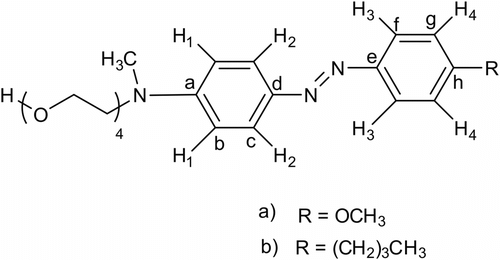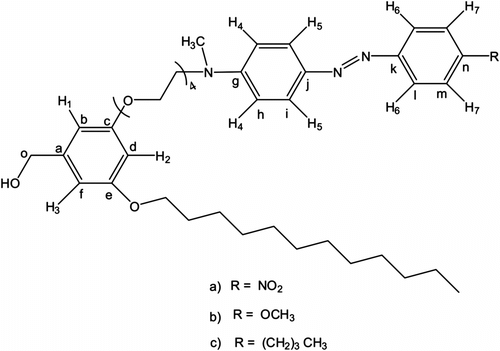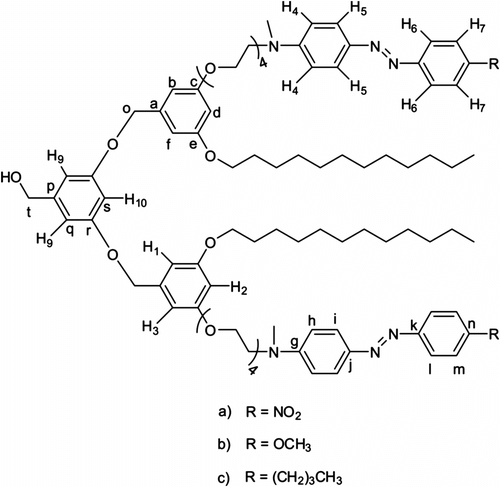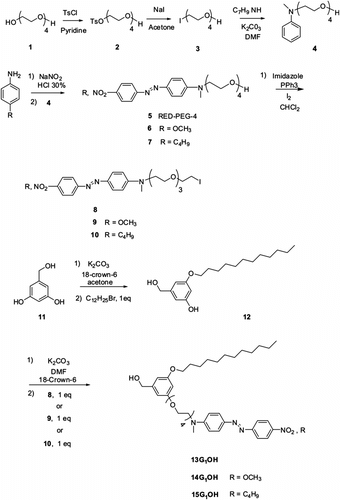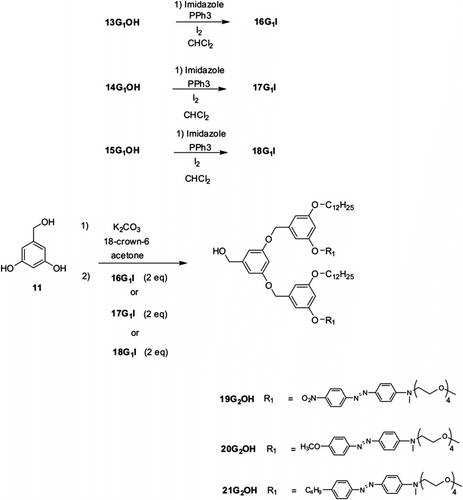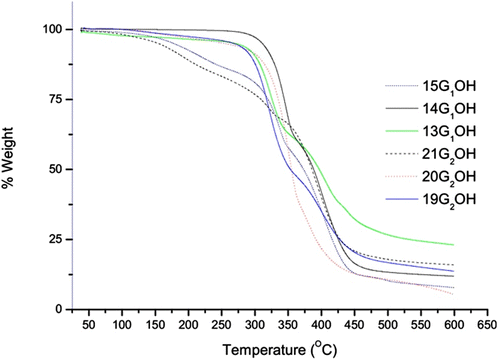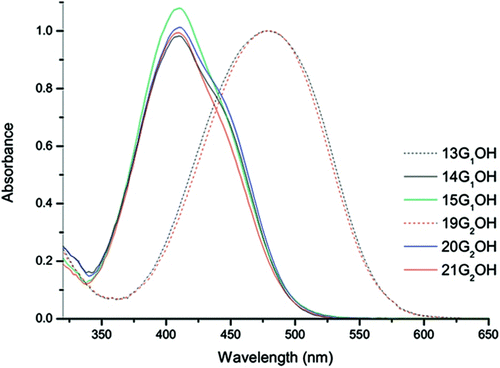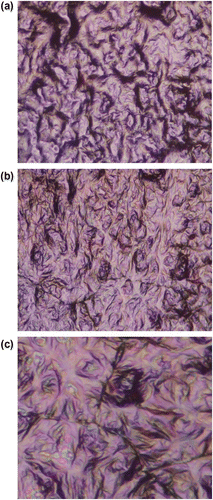Abstract
In this study, we report the synthesis and characterization of a novel series of first- and second-generation Fréchet-type dendrons bearing amino-nitro, amino-methoxy and amino-butyl substituted azobenzene units and tetra(ethylene glycol) spacers. These compounds were fully characterized by FTIR, 1H and 13C NMR spectroscopies, and their molecular weights were determined by MALDITOF. The thermal properties of the obtained dendrons were studied by thermogravimetric analysis and differential scanning calorimetry and their optical properties by absorption spectroscopy in solution. Molecular calculations were performed in order to determine the dipole moment of these molecules. Some of the dendrons showed a liquid crystalline behaviour, which was studied by light polarized microscopy as a function of the temperature in order to determine the transition temperatures and the structure of the mesophase.
Introduction
Recently, dendrimers and dendrons have been considered as one of the most attractive research fields in polymer chemistry, due to their well-defined structures and potential applications.Citation[1–4] These molecules can be modified by introducing functional groups and specific units at different levels of their structure: core, branches or periphery,Citation[5] giving rise to well-structured and highly functionalized molecules. Depending on the type of functional groups present in dendrimers, different properties have been already studied such as response to light. Some reviews include the first examples of photo-responsive dendrimers Citation[6–9] including many examples of azo-dendrimers. The most recent review covering the most important aspects of azobenzene containing dendrons and dendrimers has been published by Deloncle and Caminade.Citation[10]
At the beginning, azobenzenes had been exclusively used as terminal groups of dendrimers and dendrons; the first examples were described by Vögtle and co-workers.Citation[11] The first reported structures were prepared from poly (propyleneimine) dendrimers built from either ethylenediamine Citation[12] or 1,4-diaminobutane Citation[1–14] as core. In most of the cases, all the terminal groups were generally azobenzenes.Citation[15–18]
The most popular types of dendrimers/poly(amidoamine) dendrimers Citation[19] and poly(arylether) dendrimers Citation[20] have been rarely used as support of azobenzene moieties. The first example of Fréchet type azo-dendrimers was synthesized by grafting through their core poly(arylether) dendrons bearing a single azobenzene group on the surface, leading to original dendrimers,Citation[21–23] having azobenzene units as terminal groups.
On the other hand, dendrons have been infrequently functionalized with azobenzene units on their surface. The first example was synthesized to be used as building block for dendrimers.Citation[21,22] Besides, more sophisticated systems such as polyether dendrons linked to a fullerene as core have been prepared.Citation[24]
Rau classified azobenzenes into three main groups based on their photochemical behaviour.Citation[25] Unsubstituted photochromic azobenzene makes up the first group, known as ‘azobenzenes’. The thermally stable trans isomer exhibits a strong π–π ∗ transition at 350 nm and a weak n–π ∗ transition at 440 nm, whereas the cis isomer undergoes similar transitions but with a more intense n–π ∗ band. In addition, ‘azobenzenes’ have a relatively poor π–π ∗ and n–π ∗ overlap. The second group, known as ‘aminoazobenzenes’ typically includes azobenzenes that are substituted by an electron-donor group and are characterized by the overlapping of the π–π ∗ and n–π ∗ bands. Finally, azobenzenes bearing both electron-donor and electron-acceptor groups belong to the third category, ‘pseudostilbenes’, where the π–π ∗ and n–π ∗ bands are practically superimposed and inverted on the energy scale with respect to the ‘azobenzenes’ bands.Citation[25]
When donor–acceptor substituted azobenzenes are incorporated into a polymer backbone or side-chain, they provide very versatile materials from the applications point of view. In particular, ‘pseudostilbene’ azobenzenes undergo rapid trans-cis-trans photoisomerization when they are irradiated with linear polarized light. The use of polarized light allows the selective activation of ‘pseudostilbenes’ with polarization axis parallel to the absorbing radiation.Citation[26–32]
Azobenzene molecules can also undergo chromic changes through aggregation in various media including solution, spin-cast films and Langmuir–Blodgett layers. Both H-type and J-type aggregates have been observed.Citation[33] Although many azo-polymers bearing different architectures have been reported in the literature,Citation[34–39] very recently azobenzene and poly(ethylene glycol) have been employed in the synthesis of amphiphilic azo-dyes, copolymers,Citation[40,41] nanomaterials,Citation[42,43] cellulose derivatives Citation[44,45] and cyclodextrin polymers,Citation[46,47] sometimes forming supramolecular complexes with interesting properties.Citation[48] Poly(ethylene glycol) segments provide flexibility and water solubility to the systems to which they are incorporated.Citation[49,50]
Previously, we published the synthesis and characterization of four novel azo-dyes bearing terminal hydroxyl groups (RED-PEG series), the preparation of grafted azo-polymer films containing oligo(ethylene glycol) segments (AC-g-PE-RED-PEG series),Citation[51] and the synthesis and characterization of a new series of azo-polymers bearing RED-PEG units in their structure (pnPEGMAN series).Citation[52] Very recently, we reported the synthesis and characterization of a series of liquid crystalline dyes bearing two amino-nitro substituted azobenzene units linked by well-defined oligo(ethylene glycol) spacers (DIRED-PEG series).Citation[53]
In the last ten years, our research group has worked on the synthesis and characterization of amphiphilic azo-dyes and azo-polymers bearing oligo(ethylene glycol) segments with different architectures. Herein, we report the incorporation of high and middle dipole moment azo-dyes into Fréchet type dendrons in order to get new liquid crystalline materials bearing azobenzene units. The thermal and optical properties of these dendrons were studied in detail. Some of them exhibited a liquid crystalline behaviour, which was studied by Differential Scanning Calorimetry (DSC) and Light Polarized Microscopy as a function of the temperature.
Experimental part
General conditions
All reagents used in the synthesis of the dendrons were purchased from Aldrich and used as received, without further purification. Acetone and dichloromethane were dried by distillation over calcium hydride. Precursor dye RED-PEG-4 was synthesized according to the method previously reported by us and the poly(aryl ether) dendrons were prepared as described in the literature.Citation[54]
1H and 13C NMR spectra of these compounds in CDCl3 solution were recorded at room temperature on a Bruker Avance 400 MHz spectrometer operating at 400 and 100 MHz for 1H and 13C, respectively. Thermal properties of the obtained azo-dendrons were studied by determining T 10 (10% weight loss temperature) and T m (melting point). Thermogravimetric analysis (TGA) was conducted on a Hi-Res TGA 2950 Instrument (from 30 to 650 °C) under inert atmosphere and DSC was carried out in a DSC 2910 Instrument (from −50 to 100 °C), in both cases with a heating rate of 10 °C/min.
All dendrons were dissolved in spectral quality solvents purchased from Aldrich, and their absorption spectra were recorded on a Varian Cary 1 Bio UV-vis (model 8452A) spectrophotometer at room temperature, using 1-cm quartz cuvettes.
Molecular modelling
Molecular modelling was performed on the obtained compounds using HyperChem™ 6.03 for Windows, using the semi-empirical method PM3, employing the Polak Ribière algorithm with a maximum of 1100 cycles and RMS gradient of 0.05 kcal/Åmol.
Synthesis of the precursors azo-dyes
Precursor azo-dye RED-PEG-4 (5) was prepared according to the method previously reported by us in the literature.Citation[51]
Synthesis of the 2-{[4-(4-methoxy-phenylazo)-phenyl]-methyl-amino}-ethanol (6)
The intermediate 2-(2-{2-[2-(Methyl-phenyl-amino)-ethoxy]-ethoxy}-ethoxy)-ethanol (4) have been synthesized according to the method previously reported by us for the synthesis of the RED-PEG series. However, the diazonium salts were prepared in situ, since they are not commercially available. Then, p-anisidine (4.7 g, 3.74 mmol) and NaNO2 (2.43 g, 3.74 mmol) were dissolved in a HCl solution 30% (50 mL) at 0 °C with vigorous stirring. Then, the intermediate (4) (4.14 g, 1.16 mmol) was added dropwise, and the reaction mixture was stirred for 4 h. Afterwards, it was neutralized with a NaOH solution (10%). The crude product was extracted with CHCl3 and the organic phase was dried with anhydrous MgSO4, filtered and concentrated at reduced pressure. The resulting product was purified by column chromatography in silica gel using mixtures ethyl acetate/hexane (6:4 and 7:3) as eluent to yield the precursor dye (6). Yield: 68%.
1H NMR (400 MHz, CDCl3) (Scheme ): δ = 7.76 (d, J = 9.01 Hz, 2 H, H3), 7.75 (d, J = 9.29 Hz, 2 H, H2), 6.91 (d, J = 9.02, 2 H, H4), 6.70 (d, J = 9.23, 2 H, H1), 3.79 (s, 3H, OCH3), 3.65–3.51 (m, 16 H, NCH2 and OCH2), 3.02 (s, 3 H, NCH3) ppm.
13C NMR (100 MHz, CDCl3) (Scheme ): δ = 160.86 (1C, Ch), 151.05 (1C, Ca), 147.36 (1C, Ce), 143.65 (1C, Cd), 124.68 (2C, Cc), 123.81 (2C, Cf), 114.12 (2C, Cg), 111.59 (2C, Cb), 72.72, 70.63, 70.50, 70.18, 66.82, 61.35 (7C, OCH2), 56.33 (CH2N), 55.60 (OCH3), 39.16 (1C, CH3N) ppm.
Synthesis of the 2-{[4-(4-Butyl-phenylazo)-phenyl]-methyl-amino}-ethanol (7)
4-butyl-phenylamine (7.89 g, 5.3 mmol) and NaNO2 (3.65 g, 5.2 mmol) were dissolved in a HCl solution 30% (80 mL) at 0°C with vigorous stirring. Then, intermediate (4) (10 g, 3.5 mmol) was added dropwise, and the reaction mixture was stirred for 4 h. Afterwards, it was neutralized with a NaOH solution 10%. The crude product was extracted with CHCl3, and the organic solution was dried with anhydrous MgSO4, filtered and concentrated under vacuum. The resulting product was purified by column chromatography in silica gel using mixtures ethyl acetate/hexane (6:4 and 7:3) as eluent, to yield precursor dye (7). Yield: 59%.
1H NMR (400 MHz, CDCl3) (Scheme ): δ = 7.83 (d, J = 9.1 Hz, 2 H, H3), 7.73 (d, J = 8.7 Hz, 2 H, H2), 7.26 (d, J = 8.2 Hz, 2 H, H4), 6.76 (d, J = 9.1 Hz, 2 H, H1), 3.72–3.57 (m, 16 H, OCH2 and NCH3), 3.09(s, 3 H, NCH3), 2.57 (t, 2 H, PhCH2CH2), 1.54 (m, 2 H, PhCH2), 1.29 (m, 2H, Ph(CH2)2CH2), 0.851 (t, 3H, Ph(CH2)3CH3) ppm.
13C NMR (100 MHz, CDCl3) (Scheme ): δ = 152.67 (1C, Ca), 149.68 (1C, Ce), 148.01 (1C, Ch), 145.02 (1C, Cd), 129.98 (2C, Cg), 127.17 (2C, Cf), 126.53 (2C, Cc), 111.56 (2C, Cb), 72.72, 70.63, 70.50, 70.18, 66.82, 61.35 (7C, OCH2), 56.33 (1C, CH2N), 39.16 1C, (CH3N), 34.68 (1C, PhCH2), 33.50 (1C, PhCH2CH2), 21.84 (1C, Ph(CH2)2CH2), 13.77 (1C, Ph(CH2)3CH3) ppm.
Synthesis of the dendrons
Synthesis of the 3-Dodecyloxy-5-hydroxybenzyl alcohol (12)
A mixture of 1-bromododecane (1.12 g, 8.02 mmol), 3,5-dihydroxy benzylic alcohol (11) (1 g, 4.01 mmol), K2CO3 (4.43 g, 32 mmol) and 18-crown-6 in 500 mL of acetone was heated to reflux with vigorous stirring for 48 h. The reaction mixture was filtrated and concentrated at reduced pressure. The resulting product was purified by column chromatography in silica gel using mixtures ethyl acetate/hexane (6:4 and 7:3) as eluent, to yield (12). Yield: 68%.
1H NMR (400 MHz, CDCl3) (Scheme ): δ = 6.35(s, 2 H, H1–H3), 6.28(s, 1 H, H2), 4.46(s, 2 H, PhCH2OH), 3.80(t, 2 H, PhOCH2), 1.69(m, 2 H, PhOCH2CH2), 1.26(m, 18 H, all CH2 of the aliphatic chain), 0.88(t, 3 H, CH3) ppm.
13C NMR (100 MHz, CDCl3) (Scheme ): δ = 160.41 (1C, Cg), 157.13 (1C, Cc), 142.67 (1C, Ca), 106.32 (1C, Cf), 105.49 (1C, Cb), 101.28 (1C, Cd), 68.13 (1C, Ce), 64.91 (1C, PhOCH2), 31.88 (1C, PhOCH2CH2), 29.61, 29.41, 29.32, 29.18, 25.98, 22.64 (9C, all CH2 of the aliphatic chain), 14.05 (1C, CH3) ppm.
Synthesis of (2-{2-[2-(2-Iodo-ethoxy)-ethoxy]-ethoxy}-ethyl)-methyl-[4-(4-nitro-phenylazo)-phenyl]-amine (8)
The intermediate (5) (4.37 g, 10.11 mmol) was reacted with imidazole (0.89 g, 13.1 mmol), triphenylphosphine (3.44 g, 13.1 mmol) and iodine (3.34 g, 13.1 mmol) in 50 mL anhydrous dichloromethane at room temperature. The resulting solution was stirred for 6 h, filtered and concentrated at reduced pressure. The crude product was purified by column chromatography in silica gel, using mixtures of ethyl acetate/hexane (4:6, 5:5, and 6:4) as eluent. Since this intermediate is very instable, it was immediately used in the next reaction without further purification. Relative yield: 80%.
Synthesis of [3-dodecyloxy-5-(2-{2-[2-(2-{methyl-[4-(4-nitro-phenylazo)-phenyl]-amino}-ethoxy)-ethoxy]-ethoxy}-ethoxy)-phenyl]-methanol ( 13G1OH )
(8) (0.706 g, 229 mmol), (12) (1.14 g, 210 mmol), K2CO3 (1.58 g, 149 mmol) and 18-crown-6 were dissolved in 50 mL of anhydrous DMF, and the reaction mixture was heated with stirring at 80 °C for 48 h. Then, it was filtrated and evaporated at reduced pressure. The crude product was purified by column chromatography in silica gel using mixtures ethyl acetate/hexane (5:5, and 6:4) as eluent, to yield the first generation dendron 13G1OH. Yield: 62%.
1H NMR (400 MHz, CDCl3) (Scheme ): δ = 8.24 (d, J = 9.02 Hz, 2 H, H7), 7.84 (d, J = 9.05 Hz, 2 H, H6), 7.81 (d, J = 9.21 Hz, 2 H, H5), 6.70 (d, J = 9.23 Hz, 2 H, H4), 6.44 (s, 2 H, H1-H3), 6.31 (s, 1 H, H2), 4.53 (s, 2 H, PhCH2OH), 4.03 (t, 2 H, PhOCH2 of the tetra(ethylene glycol) chain), 3.84 (t, 2 H, PhOCH2 of the aliphatic chain), 3.75 (t, 2 H, CH2N), 3.64–3.57 (m, 12 H, OCH2), 3.06 (s, 3 H, CH3N), 1.68 (q, 2 H, PhOCH2CH2), 1.35 (q, 2 H, Ph(CH2)2CH2), 1.30–1.19 (m, 18 H, all CH2 of the aliphatic chain), 0.81 (t, 3 H, CH3) ppm.
13C NMR (100 MHz, CDCl3) (Scheme ): δ = 160.63 (1C, Cc), 160.22 (1C, Ce), 156.89 (1C, Ck), 152.67 (1C, Cn), 147.53 (1C, Cg), 143.92 (1C, Cj), 143.37 (1C, Ca), 126.08 (2C, Ci), 124.62 (2C, Cm), 122.59 (2C, Cl), 111.60 (2C, Ch), 105.60 (1c, Cb), 105.26 (1C, Cf), 101.04 (1C, Cd), 70.88, 70.77, 69.80, 67.63 (6C, OCH2), 68.68 (1C, PhOCH2 aliphatic chain), 68.22 (1C, PhOCH2 of the tetra(ethylene glycol) chain), 65.35 (1C, Co), 52.31 (1C, NCH2), 39.26 (1C, NCH3), 31.91, 29.65, 29.62, 29.59, 29.39, 29.31, 26.06, 22.65 (10C, all CH2 of the aliphatic chain), 14.03 (1C, CH3) ppm. MALDITOF: C40H58N4O8 Calcd: 722.91 Found: (m/z = 722.47).
Synthesis of the (2-{2-[2-(2-Iodo-ethoxy)-ethoxy]-ethoxy}-ethyl)-[4-(4-methoxy-phenylazo)-phenyl]-methyl-amine (9)
(6) (3.77 g, 9.0 mmol), imidazole (0.79 g, 11.7 mmol), triphenylphosphine (3.07 g, 11.7 mmol) and iodine (2.98 g, 11.7 mmol) were dissolved in 50 mL anhydrous dichloromethane at room temperature. The resulting solution was stirred for 6 h, filtered and concentrated at reduced pressure. The crude product was purified by column chromatography in silica gel using mixtures of ethyl acetate/hexane (7:3) as eluent. Since this intermediate is very instable, it was immediately used in the next step without further purification. Relative yield: 85%.
Synthesis of the [3-Dodecyloxy-5-(2-{2-[2-(2-{[4-(4-methoxy-phenylazo)-phenyl]-methyl-amino}-ethoxy)-ethoxy]-ethoxy}-ethoxy)-phenyl]-methanol ( 14G1OH0)
A mixture of (12) (2.02 g, 6.89 mmol), (9) (3.02 g, 5.73 mmol), K2CO3 (4.5 g, 32 mmol) and 18-crown-6 dissolved in 50 mL of anhydrous DMF was heated with stirring at 80 °C for 48 h. Then, the reaction mixture was filtrated and evaporated at reduced pressure. The crude product was purified by column chromatography in silica gel using mixtures ethyl acetate/hexane (5:5, 6:4 and 7.3) as eluent to yield the first generation dendron 14G1OH. Yield: 64%.
1H NMR (400 MHz, CDCl3) (Scheme ): δ = 7.83 (d, J = 9.1 Hz, 2 H, H6), 7.73 (d, J = 8.7 Hz, 2 H, H5), 7.26 (d, J = 8.2 Hz, 2 H, H7), 6.76 (d, J = 9.1 Hz, 2 H, H4), 6.50(s, 2 H, H1–H3), 6.37 (s, 1 H, H2), 4.60 (s, 2 H, PhCH2OH), 4.08 (t, 2 H, PhOCH2 of the tetra(ethylene glycol) chain), 3.90 (t, 2 H, PhOCH2 of the aliphatic chain), 3.87(s, 3 H, PhOCH3), 3.82(t, 2 H, CH2N), 3.69–3.62(m, 12 H, OCH2), 3.11(s, 3 H, CH3N), 1.74(m, 2 H, PhOCH2CH2), 1.42(m, 2 H, PhO(CH2)2CH2), 1.34–1.26(m, 16 H, all CH2 of the aliphatic chain), 0.884(t, 3 H, CH3) ppm.
13C NMR (100 MHz, CDCl3) (Scheme ): δ = 160.72 (1C, Cn), 160.34 (1C, Cc), 159.96 (1C, Ce), 150.90 (1C, Cg), 147.34 (1C, Ck), 143.51 (1C, Ca), 143.35 (1C, Cj), 124.49 (2C, Ci), 123.71 (2C, Cl), 113.99 (2C, Cm), 111.36 (2C, Ch), 105.30 (1C, Cf), 104.86 (1C, Cb), 100.56 (1C, Cd), 70.67, 70.59, 69.62, 67.33 (6C, OCH2), 68.46 (1C, PhOCH2 of the aliphatic chain), 67.97 (1C, PhOCH2 tetra(ethylene glycol) chain), 65.04 (1C, Co), 55.39 (1C, NCH2), 52.08 (1C, OCH3), 39.10 (NCH3), 31.83, 29.58, 29.52, 29.32, 29.26, 29.16, 25.96, 22.60 (10C, all CH2 of the aliphatic chain), 14.05 (1C, CH3) ppm.
MALDITOF: C41H61N3O7 Calcd: 707 Found: (707.41 m/z).
Synthesis of the [4-(4-Butyl-phenylazo)-phenyl]-(2-{2-[2-(2-iodo-ethoxy)-ethoxy]-ethoxy}-ethyl)-methyl-amine ( 10 )
The intermediate (7) (3.90 g, 8.8 mmol) was reacted with imidazole (0.77 g, 11.4 mmol), triphenylphosphine (2.99 g, 11.4 mmol) and iodine (2.90 g, 11.4 mmol) in 50 mL of anhydrous dichloromethane. The resulting solution was stirred at room temperature for 6 h, filtered and concentrated at reduced pressure. The crude product was purified by flash column chromatography in silica gel, using a mixture ethyl acetate/hexane (7:3) as eluent. Since this intermediate is very instable, it has to be immediately used in the next reaction without further purification. Relative yield: 85%.
Synthesis of the [3-(2-{2-[2-(2-{[4-(4-Butyl-phenylazo)-phenyl]-methyl-amino}-ethoxy)-ethoxy]-ethoxy}-ethoxy)-5-dodecyloxy-phenyl]-methanol ( 15G1OH )
A mixture of (12) (0.922 g, 5.5 mmol), (10) (1.44 g, 2.6 mmol), K2CO3 (2.06 g, 14.9 mmol) and 18-crown-6 dissolved in 50 mL of anhydrous DMF was heated with vigorous stirring at 80 °C for 48 h. Then, the reaction mixture was filtrated and evaporated at reduced pressure. The crude product was purified by column chromatography in silica gel using mixtures ethyl acetate/hexane (5:5, 6:4 and 7.3) as eluent, to yield the first generation dendron 15G1OH. Yield: 63%.
1H NMR (400 MHz, CDCl3) (Scheme ): δ = 7.75 (d, J = 9.05 Hz, 2 H, H6), 7.67 (d, J = 8.29 Hz, 2H, H5), 7.19 (d, J = 8.66 Hz, 2H, H7), 6.67 (d, J = 9.14 Hz, 2H, H4), 6.42(s, 2 H, H1–H3), 6.31(s, 1 H, H2), 4.48(s, 2 H, PhCH2OH), 4.08(t, 2H, PhOCH2 of the tetra(ethylene glycol) chain), 3.91 (t, 2 H, PhOCH2 of the aliphatic chain), 3.81(t, 2H, CH2N), 3.69–3.60 (m, 12 H, OCH2), 3.08 (s, 3H, CH3N), 2.65 (t, 2H, PhCH2CH2), 1.74(m, 2H, PhOCH2CH2), 1.63(m, 2H, PhCH2), 1.43–1.26(m, 20 H, Ph(CH2)2CH2 and all CH2 of the aliphatic chain), 0.93(t, 3H, CH3), 0.87(t, 3H, Ph(CH2)3CH3) ppm.
13C NMR (100 MHz, CDCl3) (Scheme ): δ = 160.45 (1C, Cc), 160.08 (1C, Ce), 151.37 (1C, Cg), 151.17 (1C, Ck), 144.66 (1C, Cn), 143.65 (1C, Cj), 143.29 (1C, Ca), 128.91 (2C, Cm), 124.79 (2C, Ci), 122.09 (2C, Cl), 111.39 (2C, Ch), 105.40 (2C, Cf), 104.98 (1C, Cb), 100.70 (1C, Cd), 70.78, 70.69, 69.70, 68.54 (6C, OCH2), 68.06 (1C, PhOCH2 of the aliphatic chain), 67.44 (1C, PhOCH2 of the tetra(ethylene glycol) chain), 65.27 (1C, Co), 52.17 (NCH2), 39.21 (NCH3), 35.48 (1C, PhCH2), 33.49 (1C, PhCH2CH2), 31.89, 29.60, 29.31, 26.02, 22.64 (10C, all CH2 of the aliphatic chain), 22.31 (1C, Ph(CH2)2CH2), 14.07 (1C, CH3), 13.89 (1C, Ph(CH2)3CH3) ppm.
MALDITOF: C44H67N3O3 Calcd: 733 Found: (m/z = 733.54).
Synthesis of [2-(2-{2-[2-(3-Dodecyloxy-5-iodomethyl-phenoxy)-ethoxy]-ethoxy}-ethoxy)-ethyl]-methyl-[4-(4-nitro-phenylazo)-phenyl]-amine ( 16G1I )
13G1OH (0.22 g, 0.44 mmol) was treated with imidazole (0.055 g, 0.80 mmol), triphenylphosphine (0.21 g, 0.80 mmol) and iodine (0.20 g, 0.80 mmol) in 50 mL anhydrous dichloromethane at room temperature. The resulting solution was stirred for 6 h, filtered and concentrated at reduced pressure. The crude product was purified by column chromatography in silica gel using a mixture ethyl acetate/hexane (5:5 and 6:4) as eluent to give 16G1I. Because of its instability, this intermediate was immediately employed in the next step. Relative yield: 65%.
Synthesis of 3,5-Bis-[3-dodecyloxy-5-(2-{2-[2-(2-{methyl-[4-(4-nitro-phenylazo)-phenyl]-amino}-ethoxy)-ethoxy]-ethoxy}-ethoxy)-benzyloxy]-phenyl}-methanol ( 19G2OH )
3,5-dihydroxy benzylic alcohol (11) (0.043 g, 0.31 mmol) was reacted with 16G1I (0.13 g, 0.015 mmol), K2CO3 (0.18 g, 1.2 mmol) and a catalytic amount of 18-crown-6 in 50 mL of dry acetone. The reaction mixture was heated to reflux for 48 h, cooled to room temperature, filtered and concentrated at reduced pressure. The crude product was purified by column chromatography in silica gel using mixtures of ethyl acetate/hexane 8:2, 9:1 and pure ethyl acetate as eluent, to give second-generation dendron 19G2OH. Yield: 45%.
1H NMR (400 MHz, CDCl3) (Scheme ): δ = 8.28 (d, J = 9.10 Hz, 4 H, H7), 7.89 (d, J = 9.01 Hz, 4 H, H6), 7.87 (d, J = 9.30 Hz, 4 H, H5), 6.75 (d, J = 9.30 Hz, 4H, H4), 6.57 (s, 2 H, H2), 6.54 (s, 4 H, H1–H3), 6.49 (s, 1 H, H10), 6.39 (s, 2 H, H9), 4.92 (s, 4 H, PhCH2OPh), 4.59(s, 2 H, PhCH2OH), 4.08 (t, 4 H, PhOCH2 of the tetra(ethylene glycol) chain), 3.89 (t, 4 H, PhOCH2 of the aliphatic chain), 3.80 (t, 4 H, NCH2), 3.70–3.60 (m, 24 H, OCH2), 3.11 (s, 6 H, NCH3), 1.74 (m, 4 H, PhOCH2CH2), 1.41 (m, 4H, PhO(CH2)2CH2), 1.33–1.25 (m, 36 H, all CH2 of the aliphatic chain), 0.87 (t, 6 H, CH3) ppm.
13C NMR (100 MHz, CDCl3) (Scheme ): δ = 160.51 (1C, Cr), 160.08 (2C, Ce–c), 156.09 (2C, Ck), 152.98 (2C, Cn), 147.29 (2C, Cg), 143.74 (2C, Cj), 143.41 (1C, Cp), 139.12 (2C, Ca), 126.50 (4C, Ci), 124.63 (4C, Cm), 122.34 (4C, Cl), 111.85 (4C, Ch), 106.03 (1C, Cb), 105.71 (4C, Cq–f), 101.31 (1C, Cs), 100.98 (2C, Cd), 70.71, 70.68, 69.96, 69.66, 67.43 (12c, OCH2), 70.81 (2C, Co), 68.54 (2C, PhOCH2 of the aliphatic chain), 68.10 (2C, PhOCH2 tetra(ethylene glycol) chain), 65.17 (1C, Ct), 55.20 (2C, NCH2), 39.33 (2C, NCH3), 31.85, 29.67, 29.64, 29.59, 29, 56, 29, 39, 29.32, 29.23, 26.03, 22.66 (20C, CH2 all of the aliphatic chain), 14.00 (2C, CH3) ppm.
MALDITOF: C87H120N8O17 Calcd: 1549.93 Found: (m/z = 1548.19).
Synthesis of the [2-(2-{2-[2-(3-Dodecyloxy-5-iodomethyl-phenoxy)-ethoxy]-ethoxy}-ethoxy)-ethyl]-[4-(4-methoxy-phenylazo)-phenyl]-methyl-amine ( 17G1I )
14G1OH (0.45 g, 0.63 mmol), imidazole (0.056 g, 0.82 mmol), triphenylphosphine (0.21 g, 0.82 mmol) and iodine (0.21 g, 0.82 mmol) were dissolved in 50 mL of anhydrous dichloromethane. The resulting solution was stirred at room temperature for 6 h, filtered and concentrated at reduced pressure. The crude product was purified by column chromatography in silica gel using a mixture of ethyl acetate/hexane (8:2) as eluent, to give 17G1I. Because of its instability, this intermediate was immediately used in the next reaction. Relative yield: 61%.
Synthesis of the {3,5-Bis-[3-dodecyloxy-5-(2-{2-[2-(2-{[4-(4-methoxy-phenylazo)-phenyl]-methyl-amino}-ethoxy)-ethoxy]-ethoxy}-ethoxy)-benzyloxy]-phenyl}-methanol ( 20G2OH )
3,5-dihydroxy benzylic alcohol (11) (0.017 g, 0.12 mmol), 17G1I (0.20 g, 0.024 mmol), K2CO3 (0.067 g, 0.48 mmol) and a catalytic amount of 18-crown-6 were dissolved in 50 mL of dry acetone. The reaction mixture was heated to reflux for 48 h, cooled to room temperature, filtered and concentrated at reduced pressure. The crude product was purified by column chromatography in silica gel using mixtures of ethyl acetate/hexane 8:2, 9:1 and pure ethyl acetate as eluent, to give second-generation dendron 20G2OH. Yield: 46%.
1H NMR (400 MHz, CDCl3) (Scheme ): δ = 7.82 (d, J = 6.01 Hz, 4 H, H6), 7.79 (d, J = 6.03 Hz, 4 H, H5), 6.96 (d, J = 8.88 Hz, 4 H, H7), 6.73 (d, J = 8.8 Hz, 4 H, H4), 6.57 (s, 2 H, H2), 6.55 (s, 4 H, H1–H3), 6.5 (s, 1 H, H10), 6.4 (s, 2 H, H9), 4.92 (s, 4 H, PhOCH2Ph), 4.58 (s, 2 H, PhCH2OH), 4.08 (t, 4 H, PhOCH2 of the tetra(ethylene glycol) chain), 3.90 (t, 4 H, PhOCH2 of the aliphatic chain), 3.85 (s, 6 H, PhOCH3), 3.80 (t, 4 H, NCH2), 3.63–3.657 (m, 24 H, OCH2), 3.05 (s, 6 H, NCH3), 1.74 (m, 4 H, PhOCH2CH2), 1.41 (m, 4 H, Ph(CH2)2CH2), 1.25 (m, 36 H, all CH2 of the aliphatic chain), 0.87 (t, 6H, CH3) ppm.
13C NMR (100 MHz, CDCl3) (Scheme ): δ = 160.77 (2C, Cn), 160.45 (2C, Cr), 160.05 (4C, Ce–c), 150.95 (2C, Cg), 147.42 (2C, Ck), 143.59 (2C, Cj), 143.50 (1C, Cp), 139.07 (2C, Ca), 124.55 (4C, Ci), 123.77 (4C, Cl), 114.04 (4C, Cm), 111.37 (4C, Ch), 106.03 (2C,Cb), 105.99 (4C, Cq–f), 101.30 (1C, Cs), 100.90 (2C, Cd), 70.77 (2C, Co), 70.74, 70.68, 70.64, 69.95, 69.64, 67.41 (12C, OCH2), 68.07 (2C, PhOCH2 of the aliphatic chain), 68.52 (2C, PhOCH2 tetra(ethylene glycol) chain), 65.13 (1C, Ct), 55.46 (2C, NCH2), 52.05 (2C, PhOCH3), 39.16 (2C, NCH3), 31.88, 29.63, 29.60, 29.58, 29.55, 29.38, 29.31, 29.22, 26.02, 22.65 (20C, all CH2 of the aliphatic chain), 14.11 (2C, CH3) ppm.
MALDITOF: C89H126N6O15 Calcd: 1518 Found: (m/z = 1518.14).
Synthesis of the [4-(4-Butyl-phenylazo)-phenyl]-[2-(2-{2-[2-(3-dodecyloxy-5-iodomethyl-phenoxy)-ethoxy]-ethoxy}-ethoxy)-ethyl]-methyl-amine ( 18G1I )
15G1OH (0.5 g, 0.68 mmol), imidazole (0.060 g, 0.88 mmol), triphenylphosphine (0.23 g, 0.88 mmol) and iodine (0.22 g, 0.88 mmol) were dissolved in 50 mL anhydrous dichloromethane. The resulting solution was stirred for 6 h at room temperature, filtered and concentrated at reduced pressure. The crude product was purified by flash column chromatography in silica gel using a mixture of ethyl acetate/hexane (8:2) as eluent to give 18G1I. This instable intermediate was immediately employed in the next reaction. Relative yield: 60%.
Synthesis of the {3,5-Bis-[3-(2-{2-[2-(2-{[4-(4-butyl-phenylazo)-phenyl]-methyl-amino}-ethoxy)-ethoxy]-ethoxy}-ethoxy)-5-dodecyloxy-benzyloxy]-phenyl}-methanol ( 21G2OH )
3,5-dihydroxy benzylic alcohol (11) (0.018 g, 0.13 mmol) was reacted with 18G1I (0.22 g, 0.26 mmol), K2CO3 (0.074 g, 0.53 mmol) and a catalytic amount of 18-crown-6 in dry acetone (50 mL). The reaction mixture was heated to reflux for 48 h, cooled to room temperature, filtered and concentrated at reduced pressure. The crude product was purified by column chromatography in silica gel using mixtures of ethyl acetate/hexane 8:2, 9:1 and pure ethyl acetate as eluent, to give second-generation dendron 21G2OH. Yield: 45%.
1H NMR (400 MHz, CDCl3) (Scheme ): δ = 7.75(d, J = 9.01 Hz, 4H, H6), 7.66(d, J = 8.24 Hz, 4H, H5), 7.19(d, J = 9.83 Hz, 2H, H7), 6.66(d, J = 9.09 Hz, 2H, H4), 6.51(s, 2H, H2), 6.48(s, 4H, H1–H3), 6.42(s, 1 H, H10), 6.33(s, 2H, H9), 4.85(s, 4H, PhCH2OPh), 4.52(s, 2H, PhCH2OH), 4.02(t, 4H, PhOCH2 of the tetra(ethylene glycol) chain), 3.83(t, 4H, PhOCH2 of the aliphatic chain), 3.74(t, 4H, NCH2), 3.58–3.54(m, 24H, OCH2), 2.99(s, 6H, NCH3), 2.58(t, 4H, PhCH2CH2), 1.67(m, 4H, PhOCH2CH2), 1.55(m, 4H, PhCH2), 1.30–1.18(m, 38H Ph(CH2)2CH2 and all CH2 of the aliphatic chain), 0.86(t, 6H, CH3), 0.80(t, 6H, Ph(CH2)3CH3) ppm.
13C NMR (100 MHz, CDCl3) (Scheme ): δ = 160.44 (2C, Cr), 160.04 (2C, Ce), 160.00 (2C, Cc), 151.37 (2C, Cg), 151.15 (2C, Ck), 144.63 (2C, Cn), 143.63 (2C, Cj), 139.07 (3C, Cp–a), 128.89 (4C, Cm), 124.77 (4C, Ci), 122.07 (4C, Cl), 111.36 (4C, Ch), 106.02 (2C, Cf), 105.62 (4C, Cq–b), 101.68 (1C, Cs), 100.87 (2C, Cd), 70.76 (2C, Co), 70.73, 70.66, 70.63, 69.63, 67.40 (12C, OCH2), 68.50 (2C, PhOCH2 of the aliphatic chain), 68.06 (2C, PhOCH2 of the tetra(ethylene glycol) chain), 65.04 (1C, Ct), 52.13 (2C, NCH2), 39.17 (2C, NCH3), 35.45 (2C, PhCH2), 33.46 (2C, PhCH2CH2), 31.86, 29.63, 29.62, 29.58, 29.55, 29.37, 29.30, 29.21, 26.00, 22.63 (20C, all CH2 of the aliphatic chain), 22.28 (2C, Ph(CH2)2CH2), 14.07 (2C, CH3), 13.89 (2C, Ph(CH2)3CH3) ppm.
MALDITOF: C95H138N6O13 Calcd: 1571 Found: (m/z = 1571.22).
Results and discussion
Synthesis of the dendrons
A convergent synthetic approach was used for the preparation of three different series of first and second generation dendrons bearing azobenzene units in the periphery, using 3,5-dihydroxy benzylic alcohol as built unit. The first series of dendrons was functionalized with amino-nitro substituted azobenzenes, the second one with amino-methoxy-susbstituted azo-dyes and the third one with amino-butyl substituted ones. The syntheses of the precursor dyes, first-generation (G1OH) and second-generation dendrons (G2OH) are shown in , respectively.
Precursor dye RED-PEG-4 (5) was prepared according to the method previously reported by us.Citation[51] Precursors (6) and (7) were prepared following the same synthetic methodology used for the synthesis of RED-PEG-4. The intermediate 2-(2-{2-[2-(Methyl-phenyl-amino)-ethoxy]-ethoxy}-ethoxy)-ethanol (4) was synthesized according to the method described by us and the diazonium salts required for the last two series were prepared in situ. Then, p-anisidine (1 eq) was reacted with NaNO2 (1 eq) in a HCl solution (30%) at 0 °C. Afterwards, (4) (1 eq) was added dropwise to the reaction mixture in order to obtain (6) with 68% yield. On the other hand, 3,5-dihydroxy benzylic alcohol (11) (1 eq) was reacted with 1-dodecyl bromide (1 eq) using K2CO3 as base and acetone as solvent in the presence of a catalytic amount of 18-crown-6 to give the asymmetric dendron (12). Intermediate (6) was treated in the presence of iodine, imidazole and PPh3 to give the corresponding alkyl iodide (9). This compound was reacted with (12), using K2CO3 as base and DMF as solvent in the presence of 18-crown-6 to give the first-generation dendron 14G1OH. Furthermore, this compound was treated with iodine, imidazole and PPh3 to give the corresponding alkyl iodide 17G1I. Finally, 3,5-dihydroxy benzylic alcohol (11) (1 eq) was reacted with 17G1I (2 eq) in the presence of K2CO3 and 18-crown-6 in acetone to give second-generation dendron 17G2OH. The other first- and second-generation dendrons were prepared following the same synthetic methodology employed for the obtainment of dendrons 14G1OH and 20G2OH. Their signal assignments are included in the experimental section.
Characterization of the dendrons
The structure of all the obtained dendrons were confirmed by 1H and 13C NMR spectroscopies, and their molecular weights and purity were confirmed by MALDITOF mass spectrometry using dithranol as matrix. The 1H NMR spectrum of 14G1OH in CDCl3 solution is shown in Figure . As we can see, there are six signals in aromatic region at 7.83, 7.73, 7.26, 6.76, 6.50 and 6.37 ppm due to the aromatic protons present in the azobenzene unit and the phenyl group H6, H5, H7, H4, H1-H3 and H2, respectively. In the aliphatic region, we can observe eight signals: a singlet at 4.60 ppm (PhCH2OH), two triplets at 4.08 (PhOCH2 of the tetra(ethylene glycol) chain, 3.90 (PhOCH2 of the aliphatic chain) followed by a singlet at 3.87 ppm (PhOCH3) and a triplet at 3.82 ppm (CH2N). In addition, a multiplet at 3.69 ppm due to the protons of the other OCH2 present in the tetra(ethylene glycol) segments and a singlet related to the methyl group NCH3 were also seen. Finally, the protons corresponding to methylenes (CH2) present in the alphatic chain appear at 1.74, 1.42, 1.34 and 0.84 ppm.
Figure 3 1H NMR spectra of: (a) First-generation dendron 14G1OH and (b) Second-generation dendron 20G2OH.
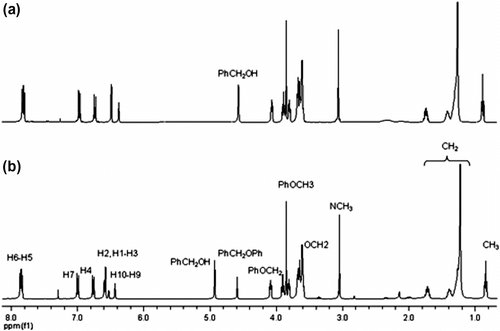
On the other hand, in the 1H NMR spectrum of 20G2OH (Figure ), we can observe almost the same chemicals shifts as in the previous case (Figure ). However, there are two additional peaks in the aromatic region at 6.5 and 6.4 ppm, which are assigned to protons H9 and H10. Moreover, a singlet at 4.58 ppm, due to the methylene protons of the PhCH2OH can be also seen.
The 13C NMR spectrum of 14G1OH is shown in Figure . As can seen, there are 14 signals in aromatic region at 160.72, 160.34, 159.96, 150.90, 147.34, 143.51, 143.35, 124.49, 123.71, 113.99, 111.36, 105.30, 104.86, 100.56 ppm due to the 14 types of aromatic carbons present in the structure of the dendron. In the aliphatic region, we can observe various peaks at 70.67, 70.59, 69.62 and 67.33 ppm due to the methylenes present in the tetra(ethylene glycol) segments. The carbons PhOCH2 of the oligo(ethylene glycol) and the aliphatic chains appear at 68.46 and 67.97 ppm, respectively. Four more signals can be perceived at 65.04, 55.39, 52.08 and 39.10 ppm, corresponding to carbons Co, NCH2, PhOCH3 and NCH3, respectively. Finally, we can perceive all the CH2 and CH3 present in the aliphatic chain at 31.83, 29.58, 29.52, 29.32, 29.26, 29.16, 25.96, 22.60 and 14.05 ppm.
Figure 4 13C NMR spectra of: (a) First-generation dendron 14G1OH and (b) Second-generation dendron 20G2OH.

On the other hand, 13C NMR spectrum of 20G2OH is illustrated in Figure . In the aromatic region, there are four peaks at 106.45, 143.50, 105.99 and 101.30 ppm due to the carbons of the phenyl group Cr, Cp, Cq and Cs, respectively. In addition, we can observe an additional peak at 65.16 ppm assigned to the carbon of the methylene (PhCH2OH).
The molecular weights of these compounds were determined by MALDITOF mass spectrometry. All the molecular weight values obtained experimentally match well with those calculated theoretically. Thus, dendrons 14G1OH and 20G2OH showed molecular ion peaks at m/z = 701.41 and m/z = 1518.14, respectively.
Thermal properties of the dendrons
Thermal properties of the dendrons were studied by TGA from 30 to 600 °C. The T 10 values (10% weight loss temperature) determined for these compounds are summarized in Table . In general, all dendrons exhibited good thermal stability up to 190 °C (Figure ). As can seen, the TGA curves of dendrons bearing amino-butyl-susbtituted azobenzenes 15G1OH and 21G2OH showed T 10 values of 219 and 192 °C, respectively. However, dendrons bearing amino-nitro- and amino-methoxy-susbtituted azobenzenes 13G1OH, 14G1OH and 19G2OH, 20G2OH exhibited T 10 values higher than 300 °C. We believe that this increase in thermal stability is due to the polarity of the NO2 and OCH3 subtituents present in the dendrons with respect to those bearing amino-butyl substituted azobenzenes (Table ). Moreover, dendrons 13G1OH and 19G2OH showed drastic degradation between 252–335 °C. The weakness of the azo group (N = N) makes these dendrons more susceptible towards degradation. It is worth to point out that first generation dendrons showed to be thermally more stable than those of second generation, since the structure of the latter is thermodynamically and sterically less stable.
Table 1. Thermal and optical properties of the dendrons.
Alternatively, T g (glass transition temperature) and T m (melting point) of the dendrons were determined by DSC; the results are summarized en the Table . DSC curves (not shown) of the dendrons bearing amino-nitro substituted azobenzenes 13G1OH and 19G2OH exhibited only an endotermic peak due to a melting point at 40 and 28 °C, respectively. No glass transition temperature value was found for these azodendrons. On the other hand, dendrons 14G1OH, 20G2OH, 15G1OH and 21G2OH clearly showed glass transitions temperatures at T g = −26.2, −14.6, −33.3 and −31.1 °C, respectively. These results are due to the presence of the flexible alkyl and oligo(thylene glycol) chains in the structure of the dendrons as well as to the low dipole moment of their azobenzene units. According to Rau’s classification, these compounds belong to the ‘aminoazobenzenes’ category.
Optical properties of the dendrons
Optical properties of the dendrons were studied in CHCl3 solution by absorption spectroscopy in the UV–vis region, and the results are summarized in the Table . The absorption spectra of high dipole moment dendrons bearing amino-nitro substituted azobenzenes (13G1OH and 19G2OH) showed a maximum absorption band at λ max = 480 nm (Figure ). High dipole moment azo-dyes usually show the typical photochemical behaviour of azobenzenes belonging to the ‘pseudostilbenes’ category. According to Rau, these compounds exhibit a total overlap of the π–π ∗ and n–π ∗ bands, which are inverted in the energy scale so that only one band can be observed in their absorption spectra.Citation[25,32] On the other hand, the absorption spectra of low dipole moment dendrons containing amino-butyl and amino-metoxy substituted azobenzenes 14G1OH, 15G1OH, 20G2OH and 21G2OH are also shown in Figure . According to Rau, these low dipole moment azo-dyes belong to the ‘aminoazobenzenes’ category and behave differently. They showed a maximum absorption band at λ max = 409 nm followed by a shoulder at λ = 423 nm. In fact, in the absorption spectra of these ‘aminoazobenzenes’ the π–π ∗ and n–π ∗ transition bands are blue shifted with respect to those of ‘pseudostilbenes’ and partially overlap Citation[25,32]. It is worth to point out that there is a significant bathochromic shift in high dipole moment dendrons bearing amino-nitro substituted azobenzenes (13G1OH and 19G2OH) due to a push-pull effect.
Study of the liquid-crystalline behaviour
The liquid-crystalline (LC) behaviour of the obtained dendrons was studied by DSC and the presence of a mesophase was confirmed by light polarized optical microscopy. The DSC curve (not shown) of the dendrons bearing amino-nitro substituted azobenzene (13G1OH) showed two endothermic peaks at 21 and 40 °C, corresponding to transition temperatures from Crystal-Liquid-crystal (T C–LC) and Liquid-crystal-Isotropic phase (T LC–I), respectively. Nevertheless, dendron 19G2OH did not exhibit any liquid crystalline behaviour; instead, it showed an endothermic peak at 28 °C due to a melting point. The optical polarized micrographs of 13G1OH showed the phase transitions upon heating, at 27 °C for the formation of the liquid crystalline phase (T C–LC) (Figure ). When the sample was heated at 33–35 °C, a liquid crystalline-isotropic transition (T LC–I) was also observed (Figure ). It is clear that the LC phase of 13G1OH exhibits a typical fan texture, which is characteristic of a smectic structure. Further heating above at 40 °C leaded to disappearance of the LC structure to adopt an isotropic phase. In contrast, the dendrons bearing amino-butyl- and amino-methoxy substituted azobenzenes did not exhibited any liquid crystalline behaviour. Unlike the other dendrons bearing low dipole moment azobenzenes, where R = OCH3 or Butyl, 13G1OH showed a very good liquid crystallinity. This can be attributed to the high dipole moment of this compound, because the presence of the amino and the nitro groups give rise intramolecular interactions between neighbour azobenzene units (mesogens), thereby favouring the orientation of the mesogenic groups in the LC phase.Citation[55]
Conclusion
Two novel series of first- and second-generation Fréchet type dendrons bearing substituted azobenzene units and tetra(ethylene glycol) spacers were synthesized and characterized. The dendrons exhibited a good thermal stability with T10 values between 192–324 °C, showing drastical degradation between 300 and 500 °C. Dendrons bearing ‘pseudostilbene’ type azobenzene units exhibited maxima absorption wavelength in the range of λ = 476–480 nm in CHCl3 solution, whereas low dipole moment dendrons did it at λ = 409 nm, which is in agreement with the results obtained by molecular modelling. DSC and Light Polarized Microscopy studies revealed that dendron 13G1OH exhibited a liquid crystalline behaviour with the formation of smectic domains.
Acknowledgments
We are grateful to Miguel Angel Canseco for his assistance with UV-vis spectroscopy and Gerardo Cedillo for his help with 1H and 13C-NMR spectroscopy. We thank Esteban Fregoso for his help with TGA and DSC measurements. We acknowledge Dr. José Reyes Gasga and Pedro Mexía Hernández for their assistance recording microscopy images. This research was financially supported by PAPIIT (Project IN-105610) and CONACYT (Project 128788).
References
- Fréchet , JMJ and Tomalia , D . 2002 . Dendrimers and other dendritric polymers , New York , NY : Wiley .
- Newkome , GR , Vögtle , F and Moorefield , CN . 2001 . Dendrimers and dendrons , Weinheim : Wiley-VCH .
- Newkome , GR and Shreiner , CD . 2008 . Poly(amidoamine), polypropylenimine, and related dendrimers and dendrons possessing different 1/2 branching motifs: an overview of the divergent procedures . Polymer , 49 : 1 – 173 .
- Jean-Pierre , Majoral and Anne-Marie , Caminade . 1999 . Dendrimers containing heteroatoms (Si, P, B, Ge, or Bi) . Chem. Rev. , 99 : 845 – 880 .
- Vögtle , F , Richardt , G and Werner , N . 2009 . Dendrimer chemistry , Weinheim : Wiley-VCH .
- Momotake , A and Arai , T . 2004 . Synthesis, excited state properties, and dynamic structural change of photoresponsive dendrimers . Polymer. , 45 : 5369 – 5390 .
- Momotake , A and Arai , T . 2004 . Photochemistry and photophysics of stilbene dendrimers and related compounds . J. Photochem. Photobiol. C. Photochem. Rev. , 5 : 1 – 25 .
- Shibaev , V , Bobrovsky , A and Boiko , N . 2003 . Photoactive liquid crystalline polymer systems with light-controllable structure and optical properties . Prog. Polym. Sci. , 28 : 729 – 836 .
- Villavicencio , O and McGrath , DV . 2002 . Advances in dendritic . Macromolecules , 5 : 1 – 44 .
- Deloncle R, Caminade Anne-Marie. Stimuli-responsive dendritic structures: the case of light-driven azobenzene-containing dendrimers and dendrons. J. Photochem. Photobiol. C. Photochem. Rev. 2010;11:25–45.
- Mekelburger , HB , Rissanen , K and Vögtle , F . 1993 . Repetitive-synthesis of bulky dendrimers a reversibly photoactive dendrimers with six azobenzene side chains . Chem. Ber. , 126 : 1161 – 1169 .
- Buhleier , EW , Wehner , W and Vögtle , F . 1978 . Cascade and nonskid-chain-like syntheses of molecular cavity topologies . Synthesis , 2 : 155 – 158 .
- Wörner , C and Mülhaupt , R . 1993 . Polynitrile and polyamine funtional poly(trimethylene imine) dendrimers . Angew. Chem. Int. Ed. Engl. , 32 : 1306 – 1308 .
- De Brabander-van den Berg EMM, Meijer EW. Poly(propylene imine) dendrimers: large-scale synthesis by hetereogeneously catalyzed hydrogenations. Angew. Chem. Int. Ed. Engl. 1993;32:1308–1311.
- Archut , A , Vögtle , F , De Cola , L , Azzellini , GC , Balzani , V , Ramanujam , PS and Berg , RH . 1998 . Azobenzene-functionalized cascade molecules: photoswitchable supramolecular systems . Chem. Eur. J. , 4 : 699 – 706 .
- Dirksen , A , Zuidema , E , Williams , RM , De Cola , L , Kauffmann , C , Vögtle , F , Roque , A and Pina , F . 2002 . Photoactivity and pH sensitivity of methyl orange functionalized poly(propyleneamine) dendrimers . Macromolecules , 35 : 2743 – 2747 .
- Schenning , AP , Elissen-Roman , C , Weener , JW , Baars , MW , Van der Gaast , SJ and Meijer , EW . 1998 . Amphiphilic dendrimers as building blocks in supramolecular assemblies . J. Am. Chem. Soc. , 120 : 8199 – 8208 .
- Alcala , R , Gimenez , R , Oriol , L , Pinol , M , Serrano , JL , Villacampa , B and Vinuales , AI . 2007 . Synthesis, characterization, and induction of stable anisotropy in liquid crystalline photo-addressable PPI dendrimers . Chem. Mater. , 19 : 235 – 246 .
- Tomalia , DA , Baker , H , Dewald , J , Hall , M , Kallos , G , Martin , S , Roeck , J , Ryder , J and Smith , P . 1985 . A new class of polymers: starburts-dendritic macromolecules . Polym. J. , 17 : 117 – 132 .
- Hawker , CJ and Fréchet , JMJ . 1990 . Preparation of polymers with controlled molecular architecture. A new convergent approach to dendritic macromolecules . J. Am. Chem. Soc. , 112 : 7638 – 7647 .
- Li S, McGrath DV. Macromolecular isomers of azobenzene-containing photochromic dendrimers. Polym. Prep. (Am. Chem. Soc., Div. Polym. Chem.) 2000;41:861–864.
- Li , S and McGrath , DV . 2000 . Effect of macromolecular isomerism on the photomodulation of dendrimer properties . J. Am. Chem. Soc. , 122 : 6795 – 6796 .
- Nithyanandhan , J , Jayaraman , N , Davis , R and Das , S . 2004 . Synthesis, fluorescence and photoisomerization studies of azobenzene-functionalized poly(alkyl aryl ether) dendrimers . Chem. Eur. J. , 10 : 689 – 698 .
- Kay , KY , Han , KJ , Yu , YJ and Park , YD . 2002 . Dendritic fullerenes (C60) with photoresponsive azobenzene groups . Tetrahedron Lett. , 43 : 5053 – 5056 .
- Rau H. Photisomerization of azobenzenes. In: Rabek JK, editor. Photochemistry and photophysics. Vol. 2. Boca Raton (FL): CRC Press; 1990. Chapter 4; p. 119–141.
- Natansohn , A and Rochon , P . 2001 . 2000 macromolecular science and engineering award lecture the versatility of azobenzene polymers . Can. J. Chem. , 79 : 1093 – 1100 .
- Todorov , T , Nikalova , L and Tomova , N . 1984 . Polarization holography. 1: a new high-efficiency organic material with reversible photoinduced birefringence . Appl. Opt. , 23 : 4309 – 4312 .
- Xie , S , Natansohn , A and Rochon , P . 1993 . Recent developments in aromatic azo polymers research . Chem. Mater. , 5 : 403 – 411 .
- Viswanathan , NK , Kim , DY , Bian , S , Williams , J , Liu , W , Li , L , Samuelson , L , Kumar , J and Tripathy , SK . 1999 . Surface relief structures on azo polymer films . J. Mater. Chem. , 9 : 1941 – 1955 .
- Ichimura , K . 2000 . Photoalignment of liquid-crystal systems . Chem. Rev. , 100 : 1847 – 1874 .
- Delaire , JA and Nakatani , K . 2000 . Linear and nonlinear optical properties of photochromic molecules and materials . Chem. Rev. , 100 : 1817 – 1846 .
- Natansohn , A and Rochon , P . 2002 . Photoinduced motions in azo containing polymers . Chem. Rev. , 102 : 4139 – 4175 .
- Kasha , M . 1963 . Energy transfer mechanisms and the molecular exciton model for molecular aggregates . Radiat. Res. , 20 : 55 – 71 .
- Dircio , J , Gelover-Santiago , A , Caicedo , C , Carreón-Castro , MP , Valdez-Hernández , Y and Rivera , E . 2012 . Synthesis and characterization of novel polythiophenes containing azobenzene units and well-defined oligo(ethylene glycol) spacers: thermal and optical properties, and preparation of langmuir films . Des. Monomers Polym. , 15 : 175 – 195 .
- Buruiana , EC , Zamfir , M , Melinte , V and Buruiana , T . 2010 . Photo-polymers containing (S)-phenylalanine and stilbene pendants: synthesis and properties of ionic polyacrylates . Des. Monomers Polym. , 13 : 21 – 32 .
- Nicolescu , FA , Jerca , VV , Draghici , C , Vuluga , DM and Vasilescu , DS . 2009 . Synthesis and characterization of novel azobenzene methacrylate monomers . Des. Monomers Polym. , 12 : 553 – 563 .
- Kıskan , B , Dogan , F , Durmaz , YY and Yagc , Y . 2008 . Synthesis, characterization and thermally-activated curing of azobenzene-containing benzoxazines . Des. Monomers Polym. , 11 : 473 – 482 .
- Buruiana , EC , Buruiana , T , Zamfir , M , Pohoata , V and Donescu , D . 2008 . Elastomeric azo-polyurethanes containing fluorescent pyrene and their photo activity . Des. Monomers Polym. , 10 : 347 – 360 .
- Huang , D , Zhang , C , Dalton , LR and Weber , WP . 2000 . Sequential synthesis of main-chain NLO oligomers which contain 4-dialkylamino-4′-(alkylsulfonyl)azobenzene chromophores . Des. Monomers Polym. , 3 : 95 – 111 .
- He , X , Zhang , HL , Yan , DL and Wang , X . 2003 . Synthesis of side-chain liquid-crystalline homopolymers and triblock copolymers with p-methoxyazobenzene moieties and poly(ethylene glycol) as coil segments by atom transfer radical polymerization and their thermotropic phase behavior . J. Polym. Sci., Part A: Polym. Chem. , 41 : 2854 – 2864 .
- Tian , YQ , Watanabe , K , Kong , XX , Abe , J and Iyoda , T . 2002 . Synthesis, nanostructures, and functionality of amphiphilic liquid crystalline block copolymers with azobenzene moieties . Macromolecules , 35 : 3739 – 3747 .
- Saito , M , Shimomura , T , Okumura , Y , Ito , K and Hayakawa , R . 2001 . Temperature dependence of inclusion-dissociation behavior between molecular nanotubes and linear polymers . J. Chem. Phys. , 114 : 1 – 3 .
- Shimomura , T , Funaki , T and Ito , K . 2002 . Circular dichroism study of the inclusion-dissociation behavior of complexes between a molecular nanotube and azobenzene substituted linear polymers . J. Incl. Phenom. Macroc. Chem. , 44 : 275 – 278 .
- Zheng , PJ , Wang , C , Hu , X , Tam , KC and Li , L . 2005 . Supramolecular complexes of azocellulose and R-cyclodextrin: isothermal titration calorimetric and spectroscopic studies . Macromolecules , 38 : 2859 – 2864 .
- Hu , X , Zheng , PJ , Zhao , XY , Li , L , Tam , KC and Gan , LH . 2004 . Preparation, characterization and novel photoregulated rheological properties of azobenzene functionalized cellulose derivatives and their α-CD complexes . Polymer , 45 : 6219 – 6225 .
- Takashima , Y , Nakayama , T , Miyauchi , M and Kawaguchi , Y . 2004 . Complex formation and gelation between copolymers containing pendant azobenzene groups and cyclodextrin polymers . Chem. Lett. , 33 : 890 – 891 .
- Ikeda , T , Ooya , T and Yui , N . 1999 . Regulation of pseudo-polyrotaxane formation between α–cyclodetrins and azobenzene-terminated poly(ethylene glycol) . Polym. J. , 31 : 658 – 663 .
- Tung , CH , Wu , LZ , Zhang , LP and Chen , B . 2003 . Supramolecular systems as microreactors: control of product selectivity in organic phototransformation . Acc. Chem. Res. , 36 : 39 – 47 .
- Rivera , E , Belletête , M , Natansohn , A and Durocher , G . 2003 . Synthesis characterization and optical properties of a novel azo-dye bearing an oligo(ethylene glycol) methyl ether side chain in solution and in the solid state . Can. J. Chem. , 81 : 1076 – 1082 .
- Rivera , E , Carreón-Castro , MP , Buendía , I and Cedillo , G . 2006 . Optical properties and aggregation of novel azo-dyes bearing an end-capped oligo(ethylene glycol) side chain in solution, solid state and langmuir-blodgett films . Dyes Pigm. , 68 : 217 – 226 .
- Rivera , E , Carreón-Castro , MP , Salazar , R , Huerta , G , Becerril , C and Rivera , L . 2007 . Preparation and characterization of novel grafted polyethylene based azo-polymers bearing oligo(ethylene glycol) spacers . Polymer. , 48 : 3420 – 3428 .
- García , T , Carreón-Castro , MP , Gelover-Santiago , A , Ponce , P , Romero , M and Rivera , E . 2012 . Synthesis and characterization of novel amphiphilic azo-polymers bearing well-defined oligo(ethylene glycol) spacers . Des. Monomers Polym. , 15 : 159 – 174 .
- Caicedo , C , Rivera , E , Valdez-Hernández , Y and Carreón-Castro , MP . 2011 . Synthesis and characterization of novel liquid-crystalline azo-dyes bearing two amino-nitro substituted azobenzene units and a well-defined, oligo(ethylene glycol) spacer . Mater. Chem. Phys. , 130 : 471 – 480 .
- Alvarez-Venicio , V , Jiménez-Nava , B , Carreón-Castro , MP , Rivera , E , Méndez , IA , Huerta , AA and Gutiérrez-Nava , M . 2008 . Synthesis and incorporation in Langmuir films of oligophenylenevinylene dendrimers bearing a polar head group and different dendritic poly(benzyl ether) branches . Polymer. , 49 : 3911 – 3922 .
- Lagugne-Labarthet , F , Freiberg , S , Pellerin , C , Pezolet , M , Natansohn , A and Rochon , P . 2000 . Spectroscopic and optical characterization of a series of azobenzene-containing side-chain liquid crystalline polymers . Macromolecules. , 33 : 6815 – 6823 .
